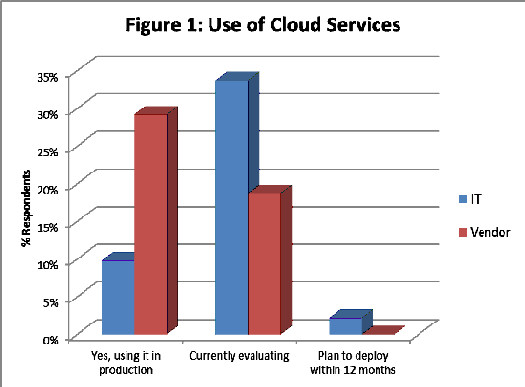In-Depth
2011: The Year of SaaS for IT Management
This is the year when enterprises will evaluate SaaS solutions for cloud-based IT management.
By Dmitry Sotnikov, Director of Cloud Solutions, Quest Software
IT professionals seem to be the most conservative crowd when it comes to the cloud. While we all have been uploading our pictures to Flickr and communicating via Facebook, and our sales reps have been utilizing Salesforce.com and doing Web demos, system administrators have stayed cautious, preferring to keep IT under their control.
Now that software as a service (SaaS) has become more widespread and commonly accepted -- and C-level executives are falling under the charm of the cloud -- something's got to give. That's definitely the expectation of the systems management vendors quickly ramping up their acquisition and development cycles to have SaaS for IT management products ready.
The Internet has changed the way we, as consumers, work with computers. At this time, SaaS is so prevalent in the consumer space, that chances are, by far, most of the applications open on your desktop as you read this are just browser windows.
Then came the cloud as a business platform. Developers quickly found that Infrastructure-as-a-Service (IaaS)/Platform-as-a-Service (PaaS) such as Amazon Web Services allowed them to quickly roll out a major Web application or perform significant computation tasks such as large-scale image recognition or financial calculations.
At the same time, business owners across sales, human resources, marketing, and other sides of business found they could easily avoid the hassle of local software installation and maintenance by using Internet-based services. The wave of successful SaaS tools such as Salesforce.com, Workday, and Webex hit the market and made the cloud a business success.
Staying on the Safe Side
Call it job security or call it healthy conservatism on the part of those actually in charge of the information technology enabling the business -- for the most part, IT stayed on the safe side and did not jump into the SaaS sea.
System administrators get their paychecks for keeping IT running. For many years, they were accustomed to enabling business with the systems they ran and being held accountable for the availability, performance, and security of IT. Frankly, letting go of this control and potentially exposing their companies to new risks did not sound like a good idea to most IT professionals, who maintained the attitude of "If I can't touch it, I can't trust it."
The Times are Changing
Holding this line is proving increasingly difficult. C-level executives, who are exposed to the cloud buzz and tired of things taking too long to implement, are seeing SaaS as a way to quickly solve their business pains while keeping costs under control. Ease of deployment and the pay-as-you-go model offered by cloud solutions just sounds too good to be ignored.
Quite often, IT gets an executive decision to implement Salesforce.com or Office 365 and, surprisingly, finds these projects don’t negatively impact IT. These imposed projects let IT get to know the cloud model, get experience in on-premise/cloud systems integration, and find that SaaS, when done right, can actually coexist with security and compliance requirements.
 |
| Figure 1 |
This is not just theory. Recent industry analyst reports show enterprise IT use of cloud services is growing and, there are some leading indicators that the SaaS adoption trend is only going to accelerate. The attendee survey conducted at The Experts Conference (TEC) 2010 showed, among IT professional respondents, that 10 percent already are using cloud services in production, and 34 percent presently are evaluating cloud services. (See Figure 1.)
Even more important, cloud service adoption among TEC software and service provider respondents is significantly higher (29 percent) than it is among the enterprise IT respondents. Since these organizations tend to adopt new technologies early to gain expertise for serving their IT customers, they are good indicators of accelerating growth.
Show Me the Products
With that kind of disruption on the way, systems management vendors are sensing the money and quickly ramping up their SaaS product sets.
Microsoft is going beyond business and communications SaaS tools and, in 2011, plans to roll out its Windows Intune offering -- giving IT professionals the ability to manage their end-users' desktops via a Microsoft-hosted service. In 2010, Citrix acquired Paglo -- a startup with a SaaS offering for asset and configuration management. This will allow Citrix to significantly ramp up its SaaS presence, which previously was limited to GoToMyPC. In June, Quest Software (the company I work for) launched its set of SaaS for IT Management, and many more cloud-based IT management services are in the works for 2011.
Sounds like 2011 will be the first year these established vendors, along with quite a few start-ups, will all get to market with compelling and highly competitive solutions to help IT professionals simplify their deployments and solve IT management tasks with the help of the cloud.
Crossing the Chasm
Historically, SaaS has been mostly a consumer or early-adopter technology, and 2011 looks like a year in which a perfect storm of wide SaaS adoption, compliance and security maturation, a business mandate to use the cloud, and a low level of IT resources for on-premise deployments all will lead system administrators to start evaluating SaaS solutions for cloud-based IT management.
That's definitely the hope of the industry rapidly ramping up SaaS offerings for IT. If all indicators are right, 2011 should the year that demand and supply happily come together.
Dmitry Sotnikov is director of cloud solutions at Quest Software. Dmitry has more than 10 years of experience working in the Windows management area, and is a Microsoft MVP, author of multiple white papers. He currently is leading Quest into the era of cloud computing -- heading the company’s IT Management-as-a-Service offerings and coordinating expansion of Quest products to management of cloud systems such as Microsoft Office 365, Google Apps, and SQL Azure. You can contact the author at Dmitry.Sotnikov@quest.com.